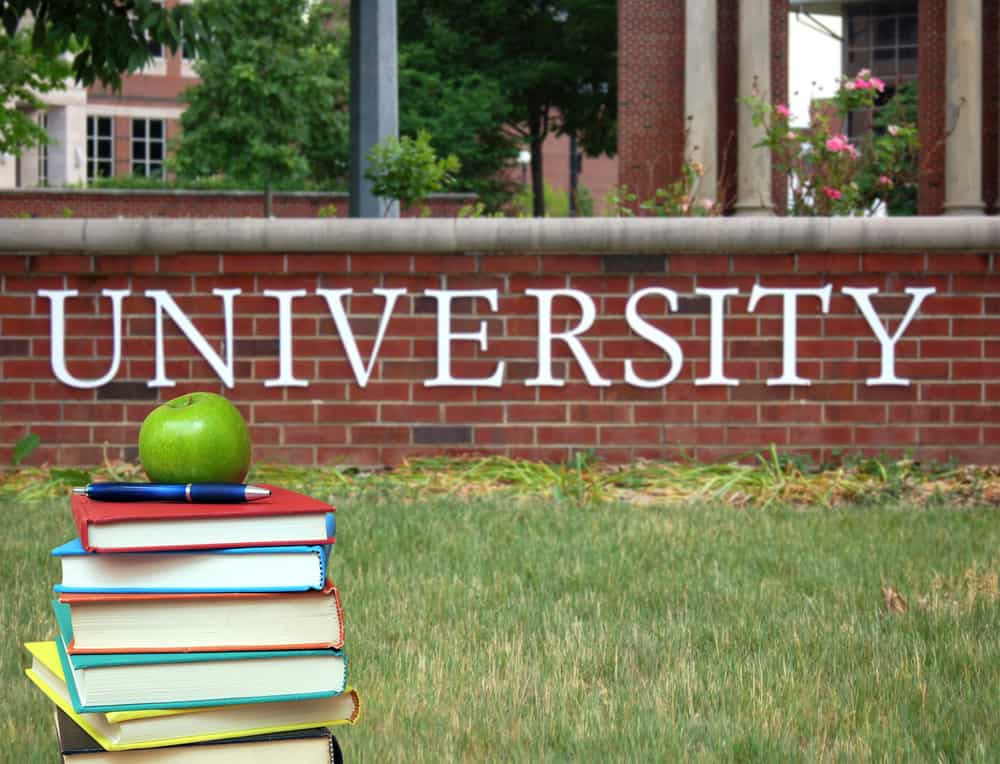
What criteria do we use to rank colleges and universities?
An Nguyen / Shutterstock
In just a few days, the US News & World Report’s annual Best Colleges Rankings will be released for 2015. The Best Colleges rankings may be the best known and most read ranking of all the colleges and universities in the United States, and a college’s high ranking on the list will become a selling point for recruiting new students. While acknowledging that “the host of intangibles that make up the college experience can’t be measured by a series of data points,” US News & World Report says that their rankings “allow you to compare at a glance the relative quality of institutions based on such widely accepted indicators of excellence as freshman retention and graduation rates and the strength of the faculty.”
For high school seniors, these rankings are a primary way to evaluate which school to choose from the dozens they may consider. In addition to how their academic performance would influence a college admissions board, whether they’ve been active enough in extracurriculars to put them ahead of other applicants, and whether or not retaking the SAT or ACT would give them the higher score needed to add a little more shine to their application, the college rankings tell prospective applicants whether or not the schools they apply to will be top choices – and top ranked – or whether they can settle for “safety schools” lower down the list in case they aren’t selected to the school of their choice.
The 28 Jesuit colleges and universities in the United States aren’t immune from the influence of the Best Colleges rankings. When the 2014 Best Colleges rankings were released last year, the Association of Jesuit Colleges and Universities issued a press release touting that “all 28 Jesuit institutions are listed near the top of their classification category among America’s ‘Best Colleges.’” The press release went on to quote AJCU president Rev. Michael J. Sheeran, SJ as saying, “The 2014 U.S. News & World Report rankings clearly demonstrate that Jesuit colleges and universities across the nation continue to rank as institutions of educational excellence.” And I have to admit, as Jesuit who’s worked in one Jesuit university and who holds a graduate degree from another, it thrills me to see our schools get that kind of recognition.
But some time ago, my friend and I started to wonder: is that really the criteria that we’re competing with as Jesuit colleges and universities? Are we just trying to play a better game than bigger, and frankly better endowed universities on the list, or aren’t we really trying to do something different altogether?
When you take a look at the mission statements of the individual Jesuit colleges and universities, they all express some variation of the idea that a Jesuit college’s mission is to form men and women for the service of others through the expression of faith in the service of justice (which I wrote about last year). Of course, that kind of mission is nowhere to be found in the US News rankings, which are focused on metrics of retention, resources, selectivity, graduation rates, and alumni giving.
My friend and I immediately decided that we needed to develop and implement our own study and ranking system for Jesuit and other Catholic colleges and universities, but based on the criteria that our schools are supposed to be achieving, like community service, post-graduate public and voluntary service, and participation in campus ministry activities. Of course, being busy graduate students ourselves, this plan remained only a great idea.

Applying to college can be stressful
chrisdorney / Shutterstock
So I was pleasantly surprised – not to mention relieved, and maybe a little disappointed – when I found out that Washington Monthly magazine has been publishing almost exactly that kind of a college ranking since 2005. As they put it, “Our rankings have always rejected the idea that expense, luxury, and exclusivity should be held up as the highest values for colleges and students to aspire to. Instead, we ask a different question: What are colleges doing for the country?” Rather than look at simple graduation rates and selectivity, the Washington Monthly rankings have a very different set of criteria:1
To identify the most public-minded institutions, we rank every four-year college and university in America based on three criteria: social mobility, research, and public service. Instead of crediting colleges that reject the most applicants, we recognize those that do the best job of enrolling and graduating low-income students. Our rankings measure both pure research spending and success in preparing undergraduates to earn PhDs. And by giving equal weight to public service, we identify colleges that build a sense of obligation to their communities and the nation at large.
Not surprisingly, that kind of a ranking system produces very different results than the US News rankings, but the biggest surprise comes right at the very top of the national university rankings. While US News gives Princeton, Harvard and Yale top spots, the Washington Monthly top rankings go to three public universities: University of California, San Diego, UC Riverside, and UC Berkeley. In this ranking, Harvard is still in the top 10 – barely – but Princeton drops down to 27, and Yale? Down to 57. Respectable on a list of 277 universities, but not the vaunted top spots they’re undoubtedly used to.
What could be behind the drop in ranking for our nation’s oldest and most respected universities, and why should it matter? Consider this recent article in the New York Times by Richard Pérez-Peña, which looks at the presence of low-income students in the nation’s elite universities. “Getting low-income students onto elite campuses is seen as a vital engine of social mobility,” the article points out. And yet, the nation’s elite universities have managed to make little progress in increasing the number of low-income students in their enrollments. “Amid promises to admit more poor students, top colleges educate roughly the same percentage of them as they did a generation ago.”
From 1982 to 2006, the percentage of students from the poorer half of the nation’s families remained roughly the same, and the article goes on:
And at a narrower, more elite group of 28 private colleges and universities, including all eight Ivy League members, researchers at Vassar and Williams Colleges found that from 2001 to 2009, a period of major increases in financial aid at those schools, enrollment of students from the bottom 40 percent of family incomes increased from just 10 percent to 11 percent.
The US News rankings “reward spending on facilities and faculty, but most pay little or no attention to financial aid and diversity,” Pérez-Peña writes, so it’s not surprising that the Washington Monthly rankings, with their equal weighting to social mobility, shifts the ranked positions of the nation’s elite schools. “Prestigious schools like Vassar, Amherst, Harvard and the University of California system have managed to increase low-income enrollment,” he points out, and correspondingly Harvard and the University of California claim most of the top 10 spots on the Washington Monthly rankings.
So what about our Jesuit colleges and universities, the ones that are trying to achieve something different in our education tradition by preparing men and women to work for the greater good? They rank strongly on the US News & World Report Best Colleges rankings, so how did they fare in Washington Monthly’s ranking system?
It’s somewhat of a mixed result. In some categories Jesuit colleges excelled, though in others we came in lower on the ranking that I would have hoped. Perhaps not surprising though, the Jesuit schools that have the hottest reputations weren’t necessarily the top-ranked even among Jesuit schools:2
- National Universities: This is the category where you find the biggest, best known Jesuit universities in the country; schools like Georgetown, Boston College, and Fordham. But it was Loyola University Chicago that beat out those other schools at number 59 out of 277 schools, high enough to put it in the top 25% of national universities. The six other Jesuit schools in this category still came in in the top 50%, although in another surprise University of San Francisco (106) beat out the other more prestigious Jesuit universities in this category.3
- Liberal Arts Colleges: Only one Jesuit college is listed in this category, College of the Holy Cross, at number 146 out of 246, low enough to place it in the bottom 50%.
- Master’s Universities: At 671 institutions, this is the largest category in the rankings, and it’s where you’ll find most of the Jesuit colleges and universities. It’s also where you’ll find our shining star, Creighton University, which took the number 1 spot. (Phew – I was starting to worry about us!) 11 other Jesuit schools placed in the top 25% as well, and all but a couple were in the top 50%.
- Baccalaureate Colleges: This category, with 346 institutions, provided another surprise, with little-known Wheeling Jesuit University, also the only Jesuit college in its category, taking the impressive number 4 spot.
- Affordable Elite Colleges: 224 colleges made this list of highly selective colleges and universities and ranked on how well they “give high-achieving non-wealthy students a break in price,” including 12 Jesuit schools. Only two, Georgetown University at 42 and College of the Holy Cross at 44 were rated affordable enough for non-wealthy students to be in the top 25% of the category. Unfortunately, 9 Jesuits schools were in the bottom 50%, including 6 that were in the bottom 25%, which raises questions about the ability and commitment of our top Jesuit schools to maintaining a preferable option for the poor, when many non-wealthy families cannot afford the high cost of tuition at our institutions.4
- Best Bank for the Buck: Fortunately, 10 Jesuit schools made it on this list of schools ranked ”based on the economic value students receive per dollar,” although none were in the top 25%.

Really, how do we measure success?
Pixelbliss / Shutterstock
So what does this all mean? Is one ranking genuinely better than the other? And does it mean that Jesuit schools lack the luster we think they do, given how they fell in this alternative ranking system? First of all, I want to be clear: Jesuit colleges and universities offer excellent education, and any student who attends one of our 28 schools can receive not only a strong education, but will have the opportunity to be formed in Jesuit ideals of discerning the common good and a priority outlook for the poor.
And for students, these ranking systems are tools that are helpful in the search, although hopefully not the deciding factor. Like I noted from US News and Report at the beginning, there are a lot of intangibles that affect the college experience. My own school ranks well on any of these lists even if not quite tops, but I had an extraordinary experience there, and I have never regretted the decision to attend my undergraduate university. Likewise, many Jesuits schools have devoted and loyal alumni groups that can attest to that.
Sure, this new ranking doesn’t measure other factors like participation in campus ministry programs, but with it’s emphasis on social mobility and service in addition to academic support, it gets closer to evaluating whether our schools are living up to the admittedly-high ideals we set forth in our mission statements. After all, Jesuits always use the word magis – more – and knowing where we stand gives us the chance to pursue it. Jesuits and our institutions have never been satisfied to settle for the status quo, and this Washington Monthly ranking system shows us that we have some work to do.
— — — — —
- Be sure to read about Washington Monthly’s full methodology here. ↩
- When clicking through and looking at each category, be sure to look at the criteria list along the top of each table so understand what Washington Monthly was considering. ↩
- My own undergraduate alma mater, University of California, Santa Cruz, also beat out most of the Jesuit universities at number 79 – Go Slugs! ↩
- Even in my case, it was the daunting cost of tuition at a Jesuit university I applied to that nudged me toward a more affordable state university. ↩


